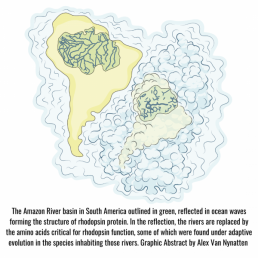As the Andes mountains were rising 15-20 million years ago, the freshwater Amazon basin became flooded with seawater. This event provided an opportunity to adapt to a freshwater habitat for marine species carried along with the seawater. University of Toronto Professors Belinda Chang and Nathan Lovejoy shed light on the resulting changes in fish vision in their new paper “Recreated ancestral opsin associated with marine to freshwater croaker invasion”.
One marine family that migrated to the Amazon basin was South American croakers, the fish that form the focus of the study. As a highly visual predatory fish which hunts in deep waters, croakers are particularly sensitive to the visual changes associated with the transition from a marine environment to a freshwater environment.
Light in the seas shifts to a blue colour as the water gets deeper whereas freshwater contains more suspended particles that scatter and absorb light, so that only red light can penetrate to the depths. Chang and Lovejoy hypothesized that the unique demands of freshwater environments may have driven certain adaptations in South American croakers, specifically in the protein rhodopsin. Rhodopsin is an abundant pigment in the fish eye that is key to vision in dim environments.
As a PhD student in the Chang and Lovejoy labs, Alex Van Nynatten studied 139 species of marine and freshwater croakers and, based on their evolutionary relationships, reconstructed the genetic sequences of the rhodopsin proteins from ancestral species before and after the habitat transition.
These genes were then used to produce the ancestral rhodopsin protein within cell cultures. The researchers were thus able to “resurrect” proteins of ancient croakers prior to their transition to freshwater and observe their properties in the lab.
Van Nynatten was excited to find that rhodopsin from freshwater croakers absorbed light that was more red-shifted compared to their marine ancestors, which is in line with the idea that rhodopsin would evolve to better detect the red-shifted light in freshwater.
There were some confusing results as well. One step in the transition to freshwater resulted in rhodopsin with a more blue-shifted absorbance. In puzzling out this result, Van Nynatten recalled that Amazon River waters are so turbid that he would lose sight of his fingers at elbow depth while collecting croakers.
His confusion turned to excitement as he realized the observed blue-shift change also allowed for faster protein kinetics. Faster kinetics improves rhodopsin’s ability to adjust vision between dark and light environments, which would be advantageous in turbid freshwater environments.
Chang and Van Nynatten note that these major changes in rhodopsin likely occurred within five million years. These results show how proteins can change significantly as organisms adapt to new environments, and very quickly, from an evolutionary standpoint.
Chang and Lovejoy’s work in the Amazon may also improve conservation efforts in Canadian waters, as their focus shifts to adaptation by North American fish. Canadian fish are facing major changes in their environments. Up until about 10,000 years ago, much of Canada was covered by the Laurentide Ice Sheet, which has now retreated. In more recent years, human activity has caused further disruptions to aquatic habitats.
Having now earned his PhD, Dr Van Nynatten plans to examine Canadian fish for signs of adaptation to these changing environments.

